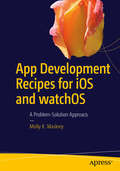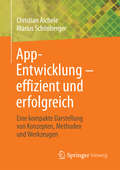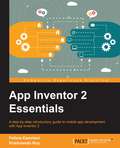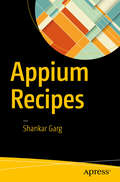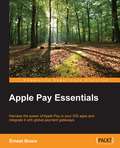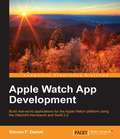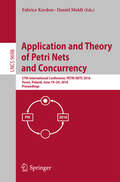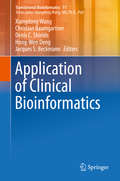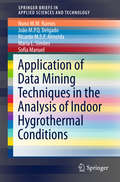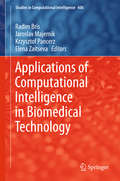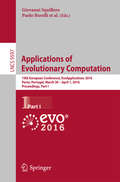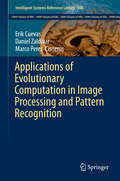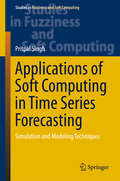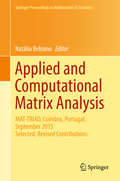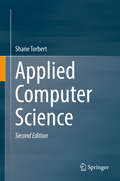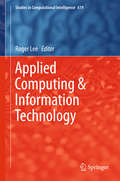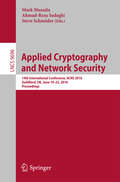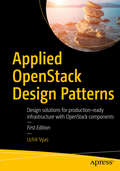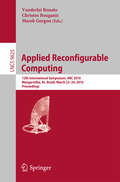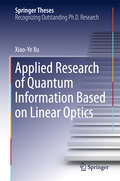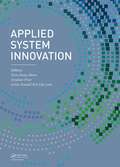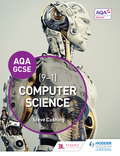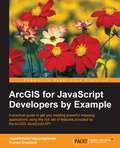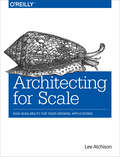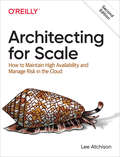- Table View
- List View
App Development Recipes for iOS and watchOS: A Problem-Solution Approach
by Molly K. MaskreyApp Development Recipes for iOS and watchOS explores the technical side of app development with tips and tricks to avoid those little things that become big frustrations, outside of the realm of development, causing many people to throw up their hands and say “It’s just not worth the hassle!” The experiential nature of this work sets it apart from other iOS and watchOS books. Even if you are a developer who is completely new to Swift, iOS or watchOS, you’ll find the right experienced-based answers to important questions like “Why do I need version control?”, “Why is testing so important?” and more specific problems directly related to iOS and watchOS development with Swift. We discover and summarize the most common problems and derive the solutions; not just a short answer and screenshot, but a systematic, logical derivation, that is, how we got to the solution. After the introductory basics, each chapter delivers a problem statement and a solution. The experienced developer may, without losing anything, skip to whatever problem with which they are currently dealing. At the same time, we guide the less experienced developer through the process with focus on solving problems along the way. What you will learn:iOS career options for the new developerWorking with Source Code and Version ControlHow to work with iOS accessory devicesUnderstanding development methodologies such as Agile/ScrumUser Experience Development and UI ToolsUnit, UI, and Beta TestingPublishing your workWho this book is for:Developers who need to find specific solutions to common problems in developing apps for iOS and watchOS.
App-Entwicklung - effizient und erfolgreich: Eine kompakte Darstellung von Konzepten, Methoden und Werkzeugen
by Christian Aichele Marius SchönbergerDieses Buch ermöglicht durch die Darstellung fachlicher und technologischer Grundlagen sowie der Beschreibung notwendiger Aktivitäten zur mobilen Anwendungsentwicklung einen Einstieg in die Thematik. Anhand eines standardisierten Vorgehensmodells werden die einzelnen Phasen der mobilen Anwendungsentwicklung aufgezeigt und die Unterstützung der phasenbezogenen Aktivitäten durch den Einsatz etablierter Entwicklungswerkzeuge dargestellt. Das Buch wendet sich vornehmlich an Unternehmer, IT-Verantwortliche und IT-Praktiker aus IT-anwendenden Unternehmen und IT-Unternehmen. Ferner an Lehrende und Studenten der Wirtschaftsinformatik und BWL.
App Inventor 2 Essentials
by Felicia Kamriani Krishnendu RoyA step-by-step introductory guide to mobile app development with App Inventor 2 About This Book * Get an introduction to the functionalities of App Inventor 2 and use it to unleash your creativity * Learn to navigate the App Inventor platform, develop basic coding skills and become familiar with a blocks based programming language * Build your very first mobile app and feel proud of your accomplishment * Follow tutorials to expand your app development skills Who This Book Is For App Inventor 2 Essentials is for anyone who wants to learn to make mobile apps for Android devices - no prior coding experience is necessary. What You Will Learn * Perform technical setup and navigate the App Inventor platform * Utilize the interactive development environment by pairing a mobile device with a computer using Wi-Fi or USB * Build three apps: a game, an event app and a raffle app * Create the user interface of the app in the Designer and program the code in the Blocks Editor * Integrate basic computer science principles along with more complex elements such fusion tables and lists * Test and troubleshoot your applications * Publish your apps on Google Play Store to reach a wide audience * Unleash your creativity for further app development In Detail App Inventor 2 will take you on a journey of mobile app development. We begin by introducing you to the functionalities of App Inventor and giving you an idea about the types of apps you can develop using it. We walk you through the technical set up so you can take advantage of the interactive development environment (live testing). You will get hands-on, practical experience building three different apps using tutorials. Along the way, you will learn computer science principles as well as tips to help you prepare for the creative process of building an app from scratch. By the end of the journey, you will learn how to package an app and deploy it to app markets. App Inventor 2 Essentials prepares you to amass a resource of skills, knowledge and experience to become a mobile app developer Style and approach Every topic in this book is explained in step-by-step and easy-to-follow fashion, accompanied with screenshots of the interface that will make it easier for you to understand the processes.
Appium Recipes
by Shankar GargLearn how Appium is implemented in Java and integrated with tools, such as TestNG, Cucumber, Maven, Jenkins and Selenium Grid to create test automation frameworks. With these frameworks, you can test Mobile Apps on simulators or real devices and create CICD pipelines. This brief book focuses on using Appium for automation on both Android and iOS platforms. Appium Recipes illustrates test automation framework and Cloud Test Lab scenarios that will empower you to take full advantage of Appium's critical features to achieve continuous integration and deployments in your live projects. Readers will also learn about mobile-specific actions such as Swipe, Scroll, and Tap, and mobile-specific locators such as iOSUIAutomator. What You'll Learn: Set up Appium for mobile, Web and Hybrid App Automation Use mobile-specific actions, such as Swipe, Scroll, and Tap Use mobile-specific locators, such as iOSUIAutomator Integrate Appium with Selenium Grid and Cloud Test Labs, such as Perfecto and Sauce Labs Who This Book Is For: Readers familiar with the basic concepts of test automation, mobile landscape, core java programming (basic)and maven, and Appium.
Apple Pay Essentials
by Ernest BruceHarness the power of Apple Pay in your iOS apps and integrate it with global payment gateways About This Book * Be it adding an Apple Pay button to your app or calculating sales tax with Apple Pay- this book gives you all the information you need to build a fully-functional Apply Pay application * Paying within iOS Apps made easier and secure with this no nonsense and powerful guide * Escape tedious payment options by creating compelling product card screens that present the Pay button, which your customers can tap to quickly order your products Who This Book Is For This book is for anyone who wants to integrate Apple Pay in their applications. Basic familiarity with programming and the Xcode developer tools is expected. What You Will Learn * Design a product card that includes the Apple Pay button * Implement the Apple Pay workflow in an efficient way * Use NSDecimalNumber objects to perform financial calculations accurately * Manage custom order information in the Apple Pay workflow and your custom order management system * Extract payment information from a payment token * Implement a secure, server-side payment-processor program * Find out everything you wanted to know about Apple Pay in iOS 9 In Detail Apple Pay, one of the most talked about offerings of the latest iOS 9 release, is a digital wallet and electronic payment system developed by Apple Inc. Paying in stores or within apps has never been easier or safer. Gone are the days of searching for your wallet, and the wasted moments finding the right card! Now you can use your credit cards and rewards cards with just a touch. It allows payment to merchants, using Near field Communication (NFC), and within iOS apps. Implementing Apple Pay within apps for payment is a bit tricky, but our book solves this problem for you. Whether you are a brand new iOS app developer or a seasoned expert, this book arms you with necessary skills to successfully implement Apple Pay in your online-payment workflow. Whether you are a brand new iOS app developer or a seasoned expert, this book arms you with the necessary skills to successfully implement Apple Pay. We start off by teaching you how to obtain the certificates necessary to encrypt customers' payment information. We will use Xcode and Objective C for the interface and Node.js for server side code. You will then learn how to determine whether the customer can use Apple Pay, and how to create payment requests. You will come to grips with designing a payment-processor program to interact with the payment gateway. Finally, we take a look at a business-focused view of Apple Pay protocols and classes. By the end of this book, you will be able to build a fully functional Apple Pay-integrated iOS app Style and approach This is an easy-to-follow guide on integrating Apple Pay in your iOS Application. With step by step instructions along with excellent screen shots you will be able to learn everything that you wanted to know about Passbook and Apple Pay in iOS 8.
Apple Watch App Development
by Steven F. DanielBuild real-world applications for the Apple Watch platform using the WatchKit framework and Swift 2.0 About This Book * Find out how to download and install the Xcode development tools before learning about Xcode playgrounds and the Swift programming language * Discover everything you need to know about the WatchKit platform architecture, its classes, as well its limitations * This book introduces you to the very latest mobile platform with hands-on instructions so you can build your very own Apple Watch apps Who This Book Is For This book is for developers who are interested in creating amazing apps for the Apple Watch platform. Readers are expected to have no prior experience of programming. What You Will Learn * Navigate within the WatchKit interface using the page-based, modal, and hierarchical navigation techniques * Work with context menus to allow your users to interact with the Apple Watch and respond to their actions to perform a task * Use the MapKit framework to display a map within the WatchKit interface to track the user's current location * Build effective user interfaces for the WatchKit platform and integrate iCloud capabilities to synchronize data between the iOS app and the WatchKit UI * Design your apps for the Apple Watch platform by adhering to the set of User Interface design guidelines set out by Apple * Reinforce image caching to display animations within the Apple Watch user interface * Explore WatchKit tables, which allow your users to purchase groceries and pay for them using Apple Pay Analyze the new layout system to ensure that your Apple Watch apps work with various screen sizes In Detail Wearable are the next wave of mobile technology and with the release of Apple's WatchKit SDK, a whole new world of exciting development possibilities has opened up. Apple Watch App Development introduces you to the architecture and possibilities of the Apple Watch platform, as well as an in-depth look at how to work with Xcode playgrounds. Benefit from a rapid introduction to the Swift programming language so you can quickly begin developing apps with the WatchKit framework and the Xcode Development IDE. Get to grips with advanced topics such as notifications, glances, iCloud, Apple pay, closures, tuples, protocols, delegates, concurrency, and using Swift Playgrounds, with each concept is backed up with example code that demonstrates how to properly execute it. Finally, discover how to package and deploy your Watch application to the Apple AppStore. By the end of this book, you will have a good understanding of how to develop apps for the Apple Watch platform, and synchronize data using iCloud between the wearable and the iOS device. Style and approach This book takes a step-by-step approach to developing applications for the Apple Watch using the Swift programming language and the WatchKit UI. Each topic is explained in a conversational and easy-to-follow style.
Application and Theory of Petri Nets and Concurrency: 37th International Conference, PETRI NETS 2016, Toruń, Poland, June 19-24, 2016. Proceedings (Lecture Notes in Computer Science #9698)
by Fabrice Kordon Daniel MoldtThis book constitutes the proceedings of the 37th International Conference on Application and Theory of Petri Nets and Concurrency, PETRI NETS 2016, held in Toruń, Poland, in June 2016. Petri Nets 2016 was co-located with the Application of Concurrency to System Design Conference, ACSD 2016.The 16 papers including 3 tool papers with 4 invited talks presented together in this volume were carefully reviewed and selected from 42 submissions. Papers presenting original research on application or theory of Petri nets, as well as contributions addressing topics relevant to the general field of distributed and concurrent systems are presented within this volume.
Application of Clinical Bioinformatics (Translational Bioinformatics #11)
by Xiangdong Wang Christian Baumgartner Denis C. Shields Hong-Wen Deng Jacques S. BeckmannThis bookelucidates how genetic, biological and medical information can be applied tothe development of personalized healthcare, medication and therapies. Focusingon aspects of the development of evidence-based approaches in bioinformaticsand computational medicine, including data integration, methodologies, toolsand models for clinical and translational medicine, it offers an essentialintroduction to clinical bioinformatics for clinical researchers andphysicians, medical students and teachers, and scientists working with human disease-based omics and bioinformatics. Dr. XiangdongWang is a distinguished Professor of Medicine. He is Director of ShanghaiInstitute of Clinical Bioinformatics, Director of Fudan University Center forClinical Bioinformatics, Deputy Director of Shanghai Respiratory ResearchInstitute, Director of Biomedical Research Center, Fudan University ZhongshanHospital, Shanghai, China; Dr. Christian Baumgartner is a Professor of HealthCare and Biomedical Engineering at Institute of Health Care Engineering withEuropean Notified Body of Medical Devices, Graz University of Technology, Graz,Austria; Dr. Denis Shields is a Professor of ClinicalBioinformatics at Conway Institute, Belfield, Dublin, Ireland; Dr. Hong-Wen Dengis a Professor at Department of Biostatistics and Bioinformatics, Tulane UniversitySchool of Public Health and Tropical Medicine, USA; Dr. Jacques SBeckmann is a Professor and Director of Section of Clinical Bioinformatics,Swiss Institute of Bioinformatics, Switzerland.
Application of Data Mining Techniques in the Analysis of Indoor Hygrothermal Conditions (SpringerBriefs in Applied Sciences and Technology)
by Nuno M. M. Ramos João M. P. Q. Delgado Ricardo M. S. F. Almeida Maria L. Simões Sofia ManuelThe main benefit of the book is that it explores available methodologies for both conducting in-situ measurements and adequately exploring the results, based on a case study that illustrates the benefits and difficulties of concurrent methodologies. The case study corresponds to a set of 25 social housing dwellings where an extensive in situ measurement campaign was conducted. The dwellings are located in the same quarter of a city. Measurements included indoor temperature and relative humidity, with continuous log in different rooms of each dwelling, blower-door tests and complete outdoor conditions provided by a nearby weather station. The book includes a variety of scientific and engineering disciplines, such as building physics, probability and statistics and civil engineering. It presents a synthesis of the current state of knowledge for benefit of professional engineers and scientists.
Applications of Computational Intelligence in Biomedical Technology (Studies in Computational Intelligence #606)
by Radim Bris Jaroslav Majernik Krzysztof Pancerz Elena ZaitsevaThis book presents latest results and selected applications of Computational Intelligence in Biomedical Technologies. Most of contributions deal with problems of Biomedical and Medical Informatics, ranging from theoretical considerations to practical applications. Various aspects of development methods and algorithms in Biomedical and Medical Informatics as well as Algorithms for medical image processing, modeling methods are discussed. Individual contributions also cover medical decision making support, estimation of risks of treatments, reliability of medical systems, problems of practical clinical applications and many other topics. This book is intended for scientists interested in problems of Biomedical Technologies, for researchers and academic staff, for all dealing with Biomedical and Medical Informatics, as well as PhD students. Useful information is offered also to IT companies, developers of equipment and/or software for medicine and medical professionals.
Applications of Evolutionary Computation: 19th European Conference, EvoApplications 2016, Porto, Portugal, March 30 -- April 1, 2016, Proceedings, Part I (Lecture Notes in Computer Science #9597)
by Paolo Burelli Giovanni SquilleroThetwo volumes LNCS 9597 and 9598 constitute the refereed conference proceedingsof the 19th European Conference on the Applications of Evolutionary Computation,EvoApplications 2016, held in Porto, Portugal, in March/April 2016, co-locatedwith the Evo* 2016 events EuroGP, EvoCOP, and EvoMUSART. The57 revised full papers presented together with 17 poster papers were carefullyreviewed and selected from 115 submissions. EvoApplications 2016 consisted ofthe following 13 tracks: EvoBAFIN (natural computing methods in businessanalytics and finance), EvoBIO (evolutionary computation, machine learning anddata mining in computational biology), EvoCOMNET (nature-inspired techniquesfor telecommunication networks and other parallel and distributed systems),EvoCOMPLEX (evolutionary algorithms and complex systems), EvoENERGY(evolutionary computation in energy applications), EvoGAMES (bio-inspiredalgorithms in games), EvoIASP (evolutionary computation in image analysis,signal processing, and pattern recognition), EvoINDUSTRY (nature-inspiredtechniques in industrial settings), EvoNUM (bio-inspired algorithms forcontinuous parameter optimization), EvoPAR (parallel implementation ofevolutionary algorithms), EvoRISK (computational intelligence for riskmanagement, security and defence applications), EvoROBOT (evolutionaryrobotics), and EvoSTOC (evolutionary algorithms in stochastic and dynamicenvironments).
Applications of Evolutionary Computation in Image Processing and Pattern Recognition (Intelligent Systems Reference Library #100)
by Erik Cuevas Daniel Zaldívar Marco Perez-CisnerosThis book presents the use of efficientEvolutionary Computation (EC) algorithms for solving diverse real-world imageprocessing and pattern recognition problems. It provides an overview of thedifferent aspects of evolutionary methods in order to enable the reader inreaching a global understanding of the field and, in conducting studies onspecific evolutionary techniques that are related to applications in imageprocessing and pattern recognition. It explains the basic ideas of the proposedapplications in a way that can also be understood by readers outside of thefield. Image processing and pattern recognition practitioners who are notevolutionary computation researchers will appreciate the discussed techniquesbeyond simple theoretical tools since they have been adapted to solvesignificant problems that commonly arise on such areas. On the other hand,members of the evolutionary computation community can learn the way in whichimage processing and pattern recognition problems can be translated into anoptimization task. The book has been structured so that each chapter can beread independently from the others. It can serve as reference book for studentsand researchers with basic knowledge in image processing and EC methods.
Applications of Soft Computing in Time Series Forecasting: Simulation and Modeling Techniques (Studies in Fuzziness and Soft Computing #330)
by Pritpal SinghThis book reports on an in-depth study of fuzzy time series (FTS) modeling. It reviews and summarizes previous research work in FTS modeling and also provides a brief introduction to other soft-computing techniques, such as artificial neural networks (ANNs), rough sets (RS) and evolutionary computing (EC), focusing on how these techniques can be integrated into different phases of the FTS modeling approach. In particular, the book describes novel methods resulting from the hybridization of FTS modeling approaches with neural networks and particle swarm optimization. It also demonstrates how a new ANN-based model can be successfully applied in the context of predicting Indian summer monsoon rainfall. Thanks to its easy-to-read style and the clear explanations of the models, the book can be used as a concise yet comprehensive reference guide to fuzzy time series modeling, and will be valuable not only for graduate students, but also for researchers and professionals working for academic, business and government organizations.
Applied and Computational Matrix Analysis: MAT-TRIAD, Coimbra, Portugal, September 2015 Selected, Revised Contributions (Springer Proceedings in Mathematics & Statistics #192)
by Natália BebianoThis volume presents recent advances in the field of matrix analysis based on contributions at the MAT-TRIAD 2015 conference. Topics covered include interval linear algebra and computational complexity, Birkhoff polynomial basis, tensors, graphs, linear pencils, K-theory and statistic inference, showing the ubiquity of matrices in different mathematical areas. With a particular focus on matrix and operator theory, statistical models and computation, the International Conference on Matrix Analysis and its Applications 2015, held in Coimbra, Portugal, was the sixth in a series of conferences. Applied and Computational Matrix Analysis will appeal to graduate students and researchers in theoretical and applied mathematics, physics and engineering who are seeking an overview of recent problems and methods in matrix analysis.
Applied Computer Science
by Shane TorbertThe second edition of this introductory text includes an expanded treatment of collisions, agent-based models, and insight into underlying system dynamics. Lab assignments are accessible and carefully sequenced for maximum impact. Students are able to write their own code in building solutions and Python is used to minimize any language barrier for beginners. Problems involving visualization are emphasized throughout with interactive graphics, image files, and plots of generated data. This text aims to establish a core learning experience around which any number of other learning objectives could be included. The text is presented in eight chapters where each chapter contains three problems and each problem develops five specific lab assignments, plus additional questions and discussion. This approach seeks to leverage the immediate feedback provided by the computer to help students as they work toward writing code creatively. All labs will scale to available hardware and free software could be used for the entire course, if desired. Lab assignments have been used since 2011 at the #1 ranked U. S. high school. It is an ideal textbook for high school courses that prepare students for advanced placement tests.
Applied Computing & Information Technology (Studies in Computational Intelligence #619)
by Roger LeeThis edited book presents scientific results of the 3nd International Conference on Applied Computing and Information Technology (ACIT 2015) which was held on July 12-16, 2015 in Okayama, Japan. The aim of this conference was to bring together researchers and scientists, businessmen and entrepreneurs, teachers, engineers, computer users, and students to discuss the numerous fields of computer science and to share their experiences and exchange new ideas and information in a meaningful way. Research results about all aspects (theory, applications and tools) of computer and information science, and to discuss the practical challenges encountered along the way and the solutions adopted to solve them.
Applied Cryptography and Network Security: 14th International Conference, ACNS 2016, Guildford, UK, June 19-22, 2016. Proceedings (Lecture Notes in Computer Science #9696)
by Ahmad-Reza Sadeghi Mark Manulis Steve SchneiderThis book constitutes the refereed proceedings of the 14th International Conference on Applied Cryptography and Network Security, ACNS 2016, held in Guildford, UK. in June 2016. 5. The 35 revised full papers included in this volume and presented together with 2 invited talks, were carefully reviewed and selected from 183 submissions. ACNS is an annual conference focusing on innovative research and current developments that advance the areas of applied cryptography, cyber security and privacy.
Applied OpenStack Design Patterns: Design solutions for production-ready infrastructure with OpenStack components
by Uchit VyasLearn practical and applied OpenStack cloud design solutions to gain maximum control over your infrastructure. You will achieve a complete controlled and customizable platform. Applied OpenStack Design Patterns teaches you how to map your application flow once you set up components and architectural design patterns. Also covered is storage management and computing to map user requests and allocations. Best practices of High Availability and Native Cluster Management are included. Solutions are presented to network components of OpenStack and to reduce latency and enable faster communication gateways between components of OpenStack and native applications. What You Will Learn: Design a modern cloud infrastructure Solve complex infrastructure application problems Understand OpenStack cloud infrastructure components Adopt a business impact analysis to support existing/new cloud infrastructure Use specific components to integrate an existing tool-chain set to gain agility and a quick, continuous delivery model Who This Book Is For: Seasoned solution architects, DevOps, and system engineers and analysts
Applied Reconfigurable Computing: 12th International Symposium, ARC 2016 Mangaratiba, RJ, Brazil, March 22–24, 2016 Proceedings (Lecture Notes in Computer Science #9625)
by Vanderlei Bonato Christos Bouganis Marek GorgonThis book constitutesthe refereed proceedings of the 12th International Symposium on AppliedReconfigurable Computing, ARC 2016, held in Rio de Janeiro, Brazil, in March2016. The 20 full papers presentedin this volume were carefully reviewed and selected from 47 submissions. Theyare organized in topical headings named: video and image processing; fault-tolerantsystems; tools and architectures; signal processing; and multicore systems. In addition, the bookcontains 3 invited papers and 8 poster papers on funded RD running and completed projects.
Applied Research of Quantum Information Based on Linear Optics (Springer Theses)
by Xiao-Ye XuThis thesis reports on outstanding work in two main subfields of quantum information science: one involves the quantum measurement problem, and the other concerns quantum simulation. The thesis proposes using a polarization-based displaced Sagnac-type interferometer to achieve partial collapse measurement and its reversal, and presents the first experimental verification of the nonlocality of the partial collapse measurement and its reversal. All of the experiments are carried out in the linear optical system, one of the earliest experimental systems to employ quantum communication and quantum information processing. The thesis argues that quantum measurement can yield quantum entanglement recovery, which is demonstrated by using the frequency freedom to simulate the environment. Based on the weak measurement theory, the author proposes that white light can be used to precisely estimate phase, and effectively demonstrates that the imaginary part of the weak value can be introduced by means of weak measurement evolution. Lastly, a nine-order polarization-based displaced Sagnac-type interferometer employing bulk optics is constructed to perform quantum simulation of the Landau-Zener evolution, and by tuning the system Hamiltonian, the first experiment to research the Kibble-Zurek mechanism in non-equilibrium kinetics processes is carried out in the linear optical system.
Applied System Innovation: Proceedings of the 2015 International Conference on Applied System Innovation (ICASI 2015), May 22-27, 2015, Osaka, Japan
by Teen-Hang Meen Stephen Prior Artde Donald LamThe 2015 International Conference on Applied System Innovation (ICASI 2015) was held May 22-27, 2015 in Osaka, Japan and provided a unified communication platform for researchers active in a wide range of research fields. Professionals from industry, academia and government were encouraged to discourse on research and development, professional practice, business and management in the information, innovation, communication and engineering fields. This conference enabled interdisciplinary collaboration between science and engineering technologists in the academic and industry fields as well as networking internationally. The conference received 1063 submitted papers, whereby 421 papers were selected by the committees to be presented at the ICASI 2015 conference. These papers were divided into 13 Regular Sessions and 13 Invited Sessions, and presented in several parallel sessions. The ICASI 2015 committees selected 226 excellent papers for publication in this proceedings volume, covering topics ranging from information technology, innovation design, communication science and engineering, industrial design, creative design, applied mathematics, computer science, design theory and cultural and creative research to electrical and electronic engineering, mechanical and automation engineering, green technology and architecture engineering and material science, among others.
AQA Computer Science for GCSE Student Book
by Steve CushingBuild student confidence and ensure successful progress through GCSE Computer Science. Our expert authors provide insight and guidance to meet the demands of the new AQA specification, with challenging tasks and activities to test the computational skills and knowledge required for success in their exams, and advice for successful completion of the non-examined assessment.- Builds students' knowledge and confidence through detailed topic coverage and explanation of key terms- Develops computational thinking skills with practice exercises and problem-solving tasks- Ensures progression through GCSE with regular assessment questions, that can be developed with supporting Dynamic Learning digital resources- Instils a deeper understanding and awareness of computer science, and its applications and implications in the wider world
ArcGIS for JavaScript Developers by Example
by Yogesh Dhanapal Jayakrishnan VijayaraghavanA practical guide to get you creating powerful mapping applications using the rich set of features provided by the ArcGIS JavaScript API About This Book * Unshackle your GIS application from a workstation! Get running with three major web mapping projects covering all the important aspects of the ArcGIS JavaScript API. * Set a strong foundation for the ArcGIS JavaScript API and modular coding with dojo. * Gain a crystal clear understanding of the ArcGIS JavaScript, and become skilled in creating exciting and interesting geospatial apps. Who This Book Is For This book is for JavaScript developers who wish to develop amazing mapping applications using the rich set of features provided by the ArcGIS JavaScript API, but more than that, a spatial frame of mind will help a long way. What You Will Learn * Find out what you need to develop a web mapping application in the ArcGIS environment * Get to know about the major features provided by the ArcGIS JavaScript API * See the coding best practices to develop modular dojo-based JavaScript applications * Get to grips with writing custom re-usable dojo modules using dojo and esri modules and dijits * Understand how to use various ArcGIS data sources and other open geospatial data available on the web * Discover how to query spatial data and get the best out of your data using analytical techniques * Master the art of rendering your map beautifully and create wonderful data visualizations using non-map objects such as charts * Grasp how to create secure and scalable web maps In Detail The book starts by explaining the basics of the ArcGIS web mapping ecosystem. The book walks you through the development of six major applications, covering a wide variety of topics such as querying, rendering, advanced data visualization and performing map analytics. It also emphasizes on writing modular code using pure dojo, which is the preferred platform for developing web GIS applications using ArcGIS JavaScript API. By the end of the book, you will have gained enough practical experience to architect a robust and visually powerful mapping application using the API. Style and approach This is a practical, hands-on guide on using the ArcGIS JavaScript API to develop mapping applications. It is packed with three progressively challenging and diverse projects that explain the plethora of API and dojo topics.
Architecting for Scale: High Availability for Your Growing Applications
by Lee AtchisonEvery day, companies struggle to scale critical applications. As traffic volume and data demands increase, these applications become more complicated and brittle, exposing risks and compromising availability. This practical guide shows IT, devops, and system reliability managers how to prevent an application from becoming slow, inconsistent, or downright unavailable as it grows.Scaling isn't just about handling more users; it's also about managing risk and ensuring availability. Author Lee Atchison provides basic techniques for building applications that can handle huge quantities of traffic, data, and demand without affecting the quality your customers expect.In five parts, this book explores:Availability: learn techniques for building highly available applications, and for tracking and improving availability going forwardRisk management: identify, mitigate, and manage risks in your application, test your recovery/disaster plans, and build out systems that contain fewer risksServices and microservices: understand the value of services for building complicated applications that need to operate at higher scaleScaling applications: assign services to specific teams, label the criticalness of each service, and devise failure scenarios and recovery plansCloud services: understand the structure of cloud-based services, resource allocation, and service distribution
Architecting for Scale: How to Maintain High Availability and Manage Risk in the Cloud
by Lee AtchisonEvery day, companies struggle to scale critical applications. As traffic volume and data demands increase, these applications become more complicated and brittle, exposing risks and compromising availability. With the popularity of software as a service, scaling has never been more important.Updated with an expanded focus on modern architecture paradigms such as microservices and cloud computing, this practical guide provides techniques for building systems that can handle huge quantities of traffic, data, and demand—without affecting the quality your customers expect. Architects, managers, and directors in engineering and operations organizations will learn how to build applications at scale that run more smoothly and reliably to meet the needs of customers.Learn how scaling affects the availability of your services, why that matters, and how to improve itDive into a modern service-based application architecture that ensures high availability and reduces the effects of service failuresExplore the Single Team Owned Service Architecture paradigm (STOSA)—a model for scaling your development organization in tandem with your applicationUnderstand, measure, and mitigate risk in your systemsUse the cloud to build highly scalable applications
